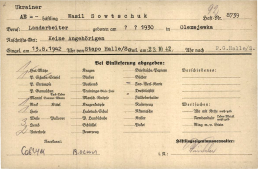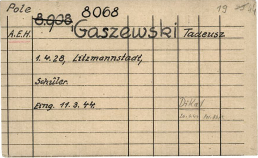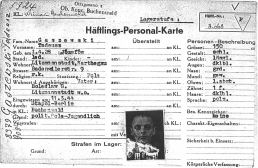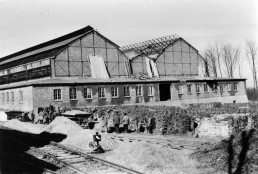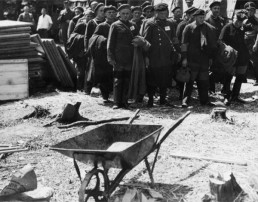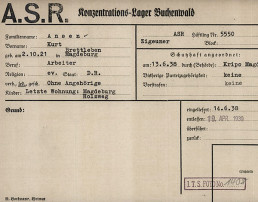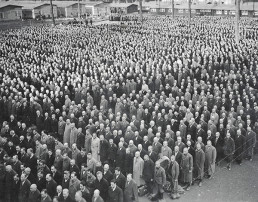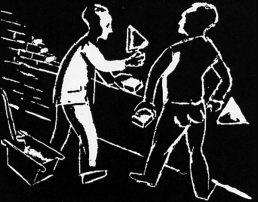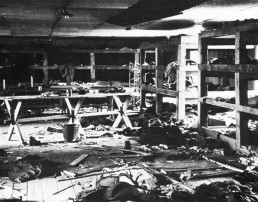Deterrence through forced labor: Disciplinary work prisoners
From 1941 to 1944, a Gestapo labor re-education camp existed at the Buchenwald Concentration Camp. Labor re-education camps (Arbeitserziehungslager, AEL) served as punishment for civilian workers, especially foreign laborers, who were accused of refusing to work. The temporary “disciplinary labor” was intended to instill a work ethic.
Between April 1941 and March 1944, almost 2,000 boys and men were sent to the Buchenwald Concentration Camp as labor re-education prisoners. The SS released most of them after three to eight weeks. Some, however, did not survive the hard forced labor.
Beginning in November 1942, nearly all prisoners in the Buchenwald AEL were children and adolescents from the Soviet Union sent there by the Gestapo. The juvenile labor re-education prisoners were housed together in Block 8, later known as the Children’s Block. From mid-1943 onwards, no AEL prisoners were released. Almost all of them remained as concentration camp prisoners at Buchenwald.
Personal effects file for Wasil Sawtschuk, 13 August 1942.
On 13 August 1942, the Halle State Police delivered 12-year-old Wasil Sawtschuk (Sowtschuk in some documents) to the Buchenwald labor re-education camp. Ten weeks later he was released and transferred back to prison in Halle. Wasil Sawtschuk was one of the youngest labor re-education prisoners at Buchenwald.
(Arolsen Archives)
From the Buchenwald Concentration Camp file on Tadeusz Gaszewski, 11 March 1944.
The Gestapo sent Tadeusz Gaszewski, a schoolboy from Litzmannstadt (Łódź), to the Buchenwald Concentration Camp on 11 March 1944. He was the last person to be admitted as a labor re-education prisoner.
(Arolsen Archives)
From the Buchenwald Concentration Camp file on Tadeus Gaszweski, 11 March 1944.
Tadeusz Gaszewski was sent to the Buchenwald Concentration Camp as a labor re-education prisoner. However, the SS registered him as a prisoner in the category “political Pole – juvenile.” It is not known if Tadeusz Gaszewski survived.
(Arolsen Archives)
Forced labor in the armaments factory. Buchenwald railroad siding at the Gustloff Plant II, 1943.
In 1942, construction of the Gustloff Plant II began at Buchenwald. After its completion, the SS’s interest in labor re-education prisoners declined, since the plant used primarily concentration camp inmates for its workforce. In 1943, the Gestapo established a central AEL for Thuringia at Röhmhild in the Thuringian Forest. Almost all prisoners sent to the Buchenwald AEL were juveniles. They had to work in the particularly difficult excavation and construction details on the premises of the Gustloff Plant II or in railroad construction. Many of them died.
(Buchenwald Memorial)
"In the Construction Detail I we had 250 young people, citizens of the Soviet Union, Poland and Jews. We were looking for ways to save the young people from perishing. [...] About 150 teenagers had to carry bricks from the storage area, where the bricks were stored, about 2000 m to the Gustloff Plant II construction sites (hall construction).The first day they carried 2 bricks on their shoulders, in their hands or arms. The second day, SS-Scharführer Schmidt’s overseers at the storage area forced them to carry 4 bricks. The SS Scharführer started yelling like rabid dogs: Carry the bricks faster, pick them up faster, run faster! And he ran alongside them for a few hundred meters. They beat the boys, making them fall down, dropping the stones in fear. The result was that broken bricks were brought to the construction site."
Report by Ernst Plaschke on the AEL prisoners as forced laborers in Buchenwald, April 1979.
Unskilled juvenile AEL prisoners had to perform particularly hard forced labor. Ernst Plaschke was Kapo of Construction Detail I in Buchenwald. After his liberation, the former political prisoner described the conditions under which the young people had to haul bricks to the Gustloff Plant II construction site.
(Buchenwald Memorial)
FURTHER INFORMATION:
Lebendiges Museum Online: Arbeitserziehungslager im Deutschen Reich. Deutsches Historisches Museum
dhm.de.
Children in the Buchenwald Concentration Camp
Aktion Arbeitsscheu Reich 1938
In 1938, the number of prisoners in the concentration camps doubled. As part of the Aktion Arbeitsscheu Reich (Operation Work-Shy Reich, two waves of arrests of purported “anti-social…
1938: Deported to Buchenwald as “special operation Jews”
In the course of the November pogroms of 1938, the Gestapo sent 30,000 Jews, designated by the SS as “special operation Jews,” to concentration camps.
Rescue Initiatives: Bricklayers’ school and Poles’ school
Under the pretext of training skilled workers for the German war effort, prisoner functionaries around Robert Siewert, a political prisoner and Kapo of the construction detail
Limited shelter: The children’s blocks 8 and 66
Children were particularly vulnerable to the dangers of the camp. To protect them, political prisoner functionaries set up a children's block in Block 8 of the main camp in July 1943.
